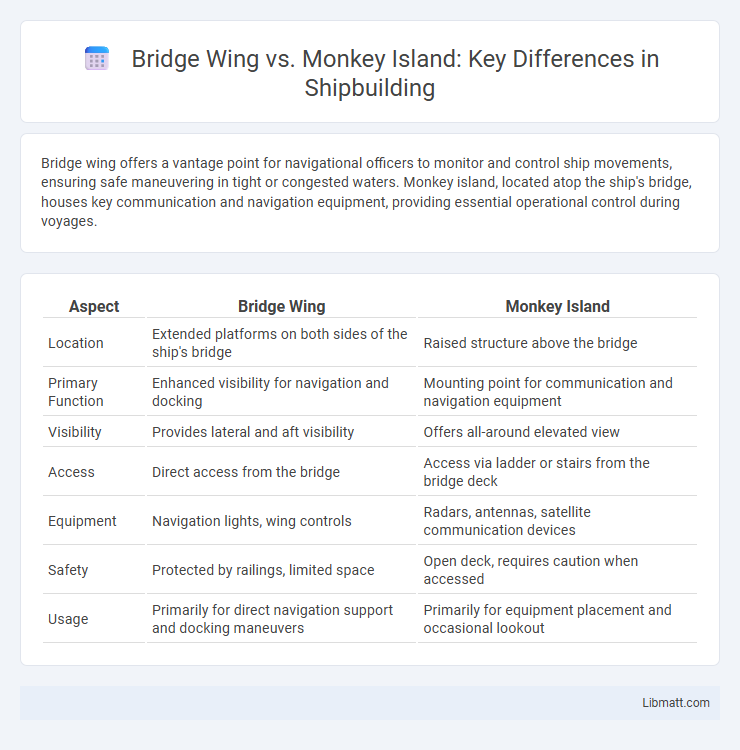Bridge wing offers a vantage point for navigational officers to monitor and control ship movements, ensuring safe maneuvering in tight or congested waters. Monkey island, located atop the ship's bridge, houses key communication and navigation equipment, providing essential operational control during voyages.
Table of Comparison
| Aspect | Bridge Wing | Monkey Island |
|---|---|---|
| Location | Extended platforms on both sides of the ship's bridge | Raised structure above the bridge |
| Primary Function | Enhanced visibility for navigation and docking | Mounting point for communication and navigation equipment |
| Visibility | Provides lateral and aft visibility | Offers all-around elevated view |
| Access | Direct access from the bridge | Access via ladder or stairs from the bridge deck |
| Equipment | Navigation lights, wing controls | Radars, antennas, satellite communication devices |
| Safety | Protected by railings, limited space | Open deck, requires caution when accessed |
| Usage | Primarily for direct navigation support and docking maneuvers | Primarily for equipment placement and occasional lookout |
Introduction to Bridge Wing and Monkey Island
Bridge Wing and Monkey Island are critical structures on a ship designed to enhance navigation and visibility. The Bridge Wing extends from both sides of the ship's main bridge, allowing the crew to observe blind spots and perform docking maneuvers with precision. Monkey Island, located above the bridge, houses essential navigation equipment and offers an elevated vantage point for improved situational awareness.
Historical Evolution of Ship Superstructures
The historical evolution of ship superstructures reveals distinct developments in bridge wing and monkey island designs; bridge wings emerged to extend visibility and maneuverability on modern vessels, enhancing navigational precision in confined waters. Monkey islands, originally elevated platforms on older steamships, provided a strategic vantage point for better ship handling and communication. Your understanding of these structures highlights their adaptation from traditional maritime practices to contemporary shipbuilding innovations for improved operational control.
Key Functions of the Bridge Wing
The bridge wing provides essential visibility and control over the ship's exterior, allowing the officer to monitor navigation, docking, and maneuvering operations safely from an extended vantage point. Unlike the monkey island, which primarily serves as an elevated open platform for lookout and communication equipment, the bridge wing integrates critical control stations such as engine telegraphs and steering controls. This setup enhances situational awareness and facilitates precise ship handling during complex operations like berthing and navigating confined waters.
Primary Roles of the Monkey Island
The primary roles of the monkey island on a ship include serving as an elevated platform for navigation and lookout, enhancing the visibility around the bridge area. It acts as a critical vantage point for the captain and officers to monitor sea traffic and environmental conditions effectively. Unlike the bridge wing, which provides extended lateral control and direct communication with the deck crew during maneuvers, the monkey island focuses on strategic oversight and command during navigation.
Structural Differences: Bridge Wing vs Monkey Island
Bridge wings are lateral extensions on either side of a ship's bridge, providing enhanced visibility for navigation and docking operations, featuring flat platforms with guardrails. Monkey Islands are elevated structures located above the bridge, often housing communication and navigation equipment, designed to provide an unobstructed 360-degree view from a higher vantage point. Structurally, bridge wings offer direct access from the main bridge level, while monkey islands are separate, raised decks requiring access via ladders or stairways.
Navigational Importance: A Comparative Analysis
The bridge wing and monkey island each play crucial roles in a vessel's navigational framework, with the bridge wing offering extended visibility along the ship's sides for precise maneuvering and docking. The monkey island, elevated above the bridge, provides an unobstructed 360-degree vantage point essential for assessing wide-area navigation and monitoring weather conditions. Understanding these differences enhances your situational awareness and safety by leveraging the strategic viewpoints unique to each platform during critical navigational operations.
Visibility and Operational Advantages
Bridge wings provide enhanced visibility for bridge officers by extending the field of view laterally, allowing better monitoring of blind spots and close-quarters maneuvering, which is crucial during docking and navigation in confined waters. Monkey islands, positioned higher above the main bridge, offer an elevated vantage point that improves long-range visibility over the bow and surrounding areas, benefiting lookout duties and early hazard detection. Operationally, bridge wings facilitate immediate helm communication and easier access for crew during close operations, while monkey islands enhance situational awareness for strategic decision-making and navigation planning.
Safety Features and Crew Accessibility
Bridge wings provide enhanced safety features by offering unobstructed views and protected walking areas for crew members, reducing risks during navigation and monitoring. Monkey islands, positioned above the bridge, offer elevated vantage points but often lack enclosed walkways, potentially exposing crew to harsh weather conditions and limiting safe access. Your choice should prioritize bridge wings for improved crew accessibility and safer operational environments during vessel maneuvers.
Modern Technological Integrations
Bridge wing designs incorporate advanced sensor arrays and integrated control panels that enhance real-time vessel monitoring and navigation precision, leveraging GPS and radar technologies for improved situational awareness. Monkey islands, while traditionally elevated platforms for better visual observation, have evolved to include modern communication systems and automated signaling devices to support coordination during complex maritime operations. These technological integrations optimize operational efficiency and safety for bridge wings and monkey islands in contemporary ship design.
Conclusion: Choosing Between Bridge Wing and Monkey Island
Selecting between a bridge wing and a monkey island depends on the vessel's operational needs and visibility requirements. Bridge wings extend the main bridge outward, providing unobstructed lateral views essential for maneuvering and docking. Monkey islands offer elevated platforms that enhance overall vantage points but may limit direct control access compared to bridge wings.
Bridge wing vs monkey island Infographic

 libmatt.com
libmatt.com